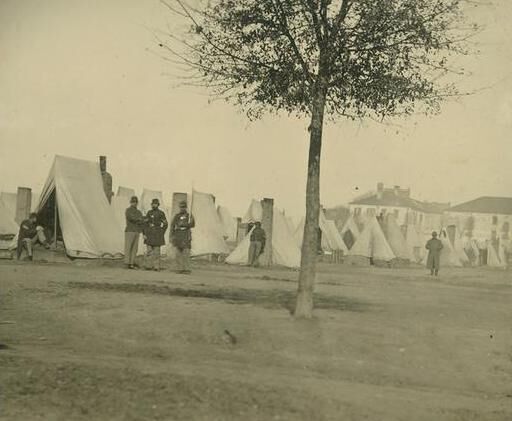History of the State Penitentiary
Credit: Postcard of State Penitentiary in Baton Rouge, La; c. 1900; Elizabeth "Penny" Nichols via East Baton Rouge Parish Library Digital Archive.
1835- The First Penitentiary:“The Walls,” Baton Rouge
Louisiana’s first State penitentiary, called “The Walls,” was located in the present-day downtown of Baton Rouge. Little remains of that first penitentiary: only the Warden’s House is still standing.
1844- Convict Leasing System Begins
Since “The Walls” failed to be self-sufficient, the state entered into its first convict lease with McHatton-Pratt & Company. This system would continue for the next 56 years and was only interrupted by the Civil War. Prisoners who were leased were forced to work under harsh conditions. Prisoners who remained at “The Walls” maintained the prison grounds and manufactured clothing and shoes for prisoners in factories.
Credit: Andrew D. Lytle Collection, Louisiana State University Library Special Collections.
1862- Civil War Occupation and Evacuation of Prison
During the American Civil War, “The Walls” was occupied by the Union Army. After a musket ball landed in the penitentiary yard, it was decided to evacuate prisoners to New Orleans. Prisoners did not return to “The Walls” until after the Civil War had ended in 1866.
1870- The James Convict Lease
After the Civil War destroyed Louisiana’s economy, public pressure for transparent and profitable corrections faded. In 1870, former Confederate Major Samuel L. James was awarded the lease of Louisiana State Penitentiary and all of its convicts. The James Lease ushered a new direction for corrections in Louisiana where conditions of accountability and transparency in the lease were ignored. The majority of black inmates were subleased to land owners to replace slaves while others continued levee, railroad, and road construction. White inmates, seen as more intellectual, were given clerk and craftsmanship work. Those few prisoners who remained at “The Walls” continued manufacturing textiles. Because most prisoners were subleased, “The Walls” primarily functioned as a receiving center.
Credit: Andrew D. Lytle Collection, Louisiana State University Library Special Collections.
1880- From Plantation to James Prison Camp
Desiring the status of a wealthy landowner, James purchased several plantations across Louisiana, one of which was the original Angola Plantation. James moved a small number of male and female prisoners under his control to Angola. The men worked the plantation fields, and the women maintained the house. Angola then became known as the James Prison Camp. The remaining prisoners held under the lease continued to work on levee and railroad construction, or farm work at other plantations.
1886- Public Outcry and Reform
Conditions for inmates at Angola and levee and railroad worksites grew harsher while James enjoyed the support and protection of the Governor. As James forced inmates to work harder and longer, inmate deaths began rising and sparked a public outcry, which led to the formation of the Prison Reform Association in New Orleans. This group of concerned citizens passionately opposed the convict leasing system from which James had greatly profited.
1898- Convict Leasing Banned
Through the advocacy of the Prison Reform Association and other civic groups, a constitutional ban of convict leasing was successfully adopted. The 1898 Constitution of the State of Louisiana stated that“no convict sentenced to the State penitentiary shall ever be leased,” effective at the end of the James Lease.
Credit: Fonville Winans(1911-1992);Gift of Meriget Winans Turner, 2008.
1901- Angola State Farms and The Board of Control
The State of Louisiana purchased the prison camp from the James family in 1900 and resumed control of its prisoners in 1901 after fifty-six years of convict leasing and conditions for inmates begin to improve. During this time, Corrections were overseen by a three-member panel appointed by the Governor, called The Board of Control. However, mismanagement and economic pressures caused the state legislature to abolish the Board of Control in 1916 and appoint Angola State Farms’ first General Manager, Henry L. Fuqua.
Credit: Fonville Winans(1911-1992);Gift of Meriget Winans Turner, 2008.
1917- Convict Guard System Begins
General Manager Fuqua established the convict guard system to reduce operation costs on the State, firing most security officers at the state penitentiary. Under the convict guard system, inmates with good behavior, called “trusty guards,” became lower tier officers for the penitentiary. In 1916,“The Walls” officially closed and was sold to the City of Baton Rouge.
1922- The Flood of 1922 and Expansion of Angola
One of the most catastrophic floods in Louisiana’s history occurred in 1922. Once the Mississippi River breached the levee near the prison, the waters rose so rapidly it trapped several prisoners in the massive sugar refinery. Prisoners and staff were soon after evacuated by ferry. After the flood, General Manager Fuqua propositioned the owners of the adjacent former plantations to purchase the properties. The property owners, tired of continual flooding, happily sold the remaining former plantations to the State increasing the penitentiary to its current size of 18,000 acres.
Credit: On loan from the Louisiana Department of Public Safety and Corrections.
1935- Despair, A Mass Escape, and The Red Hat Cell Block
As the Great Depression and World War II became the public’s main concern, the penitentiary faded from public scrutiny and collapsed into despair, the State significantly cut its budget, and it became concealed in secrecy, corruption, and brutality. With inmate mortality rates significantly high, a mass escape was organized in 1933 by Charlie Frazier, one of Louisiana’s most notorious prisoners. In the process of the escape, two employees and one convict guard were killed. The successful mass escape led to the building of the first cell block, The Red Hat, for inmates it considered as the most dangerous. It received its name because inmates housed there were required to wear hats dipped in red paint to be immediately identifiable to guards while working in the fields. The infamous legacy of the Red Hat is shrouded in myth and legend, and it allegedly subjected its inhabitants to unparalleled conditions.
Credit: On loan from the Louisiana State Museums.
1940- The Traveling Electric Chair
Until 1940, the State’s legal method of execution was by hanging, but that changed when the legislature switch to electrocution. An older law, however, presented a strange predicament: Executions were required to take place in the parish (Louisiana’s equivalent to a county) where the crime was committed. To meet that requirement, Louisiana adapted a van to house the electric chair and its generator and would transport it to the appropriate parish for scheduled executions. Louisiana’s first legal execution using the traveling electric chair was on September 11, 1941 in Livingston Parish.
1951- “Hell on Angola” and The Heel String Gang
Conditions at the state penitentiary continued to deteriorate. After a series of exposés in the 1930s and 1940s, national scrutiny culminated when several inmates slashed their Achilles tendons to protest brutality, working conditions, housing conditions, a lack of quality food, and prison mismanagement. The prison became known as America’s worst prison, and with a national spotlight, Louisiana’s new Governor sought to implement comprehensive progressive reforms.
Credit: On loan from the Louisiana Department of Public Safety and Corrections.
1955- The Main Prison
To achieve the new reforms, the State significantly increased the prison operating budget and appropriated funds to build the main prison complex, which is still in use as its main prison facility today. The increased budget and new complex allowed officials to introduce new rehabilitative programs and new professional staff to administer the programs.
Credit: On loan from the Louisiana Department of Public Safety and Corrections.
1956- The Electric Chair Travels No More
In 1956, the legislature permanently moved executions to the state penitentiary, where a small room was built beside the Red Hat to house the Electric Chair. Eleven execution were held there from 1956 to 1961 until a moratorium began in 1961.
1962- “The Bloodiest Prison in the South”
Reforms at the prison began to stall over the coming years, coinciding directly with another reduced operating budget, and conditions started to decline again. Stabbings became so commonplace that it earned the reputation as“the bloodiest prison in the South.” As a result, inmates sued the state in the early 1970s over the harsh conditions, and a federal court mandated reform.
1972- Reform and the Reformers
In 1972, Elayn Hunt was appointed as the head of Louisiana’s Department of Corrections. Hunt, the first female head of corrections in the state and second in the country, was a fierce advocate for practical criminal justice reform in Louisiana and was tasked with implementing court ordered reforms, including the ending of the “trusty guard system” and the decentralizing of the state penitentiary. After Hunt passed away in 1976, her successors continued her legacy of aggressively implementing rehabilitative reforms at the prison until, in 1977, inmate violence dramatically decreased, and the violent death rate plummeted to zero.
1976- Decentralization of Angola
C. Paul Phelps took the reins of the Department of Corrections after Hunt’s death and continued her work to institute meaningful reforms. In fulfillment of Hunt’s ultimate goal of decentralizing the Louisiana State Penitentiary, Phelps oversaw the expansion of facilities throughout the state to include Dixon Correctional Institute, Elayn Hunt Correctional Center, and the Louisiana Corrections Institute for Women, among others.
Credit: Angola Museum/The Angolite
1991- The First Lethal Injection
Louisiana’s legislature retired Louisiana State Penitentiary’s notorious electric chair in 1990, with the first legal execution by lethal injection occurring in 1991. Between 1991 and 2019, eight condemned inmates have been executed by injection.
Credit: The Angolite
1994- Reentry and Opportunities for Change
In 1994, all of Louisiana’s correctional facilities became fully accredited by the American Correctional Association. Continuing the spirit of reform and rehabilitation, the Department of Corrections integrated numerous evidence-based reentry programs throughout its facilities to increase parole compliance, decrease recidivism, and reduce barriers offenders face when seeking opportunities to change and reintegrate into our communities.
2017- Louisiana’s Criminal Justice Reform
Louisiana’s Justice Reinvestment Task Force, chaired by Corrections Secretary James LeBlanc, proposed a criminal justice reform package to the legislature. Signed into law in 2017 by Governor John Bel Edwards, the ambitious reform is projected to reduce Louisiana’s prison population and save over $200 million through the next decade, which will be reinvested into programs to reduce recidivism and support victims.











